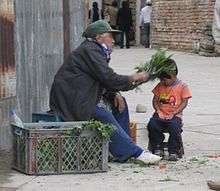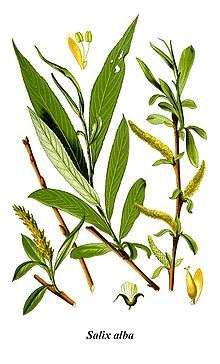Curandero
A curandero (Spanish: [kuɾanˈdeɾo], healer; f. curandera) or curandeiro (Portuguese: [kuɾɐ̃ˈdejɾu], f. curandeira) is a traditional native healer/shaman found in Latin America, the United States and Southern Europe. The curandero's life is dedicated to the administration of remedies for mental, emotional, physical and spiritual illnesses.[1][2][3][4] The role of a curandero can also incorporate the roles of psychiatrist along with that of doctor and healer. Some curanderos, such as Don Pedrito, the Healer of Los Olmos, make use of simple herbs, waters, and even mud to effect their cures. Others add Catholic elements, such as holy water and pictures of saints. The use of Roman Catholic prayers and other borrowings and lendings is often found alongside native religious elements. Many curanderos emphasize their native spirituality in healing while being practicing Roman Catholics.

Curanderos are often respected members of the community. Believers consider their powers to be supernatural and think that many illnesses are caused by lost malevolent spirits, a lesson from God, or a curse.
History in Latin America
The term curanderos can be traced back to the Spanish colonization of Latin America. Curanderos in this part of the world are the result of the mixture of traditional Indigenous medicinal practices and Catholic rituals. There was also an influence from African rituals brought to Latin America by slaves. [5] The term stems from the Spanish word for "to heal", curar. Curanderos go beyond Western medicine, linking illness with evil spirits. This extends a curandero's duties to cover not only physical ailments but also psychological and interpersonal issues. Traditional communities see all of these issues as a loss of spirit.[6] They believe that the curanderos can enter different dimensions where they are able to find the solutions to a person's illness or problem. Furthermore, they believe that God or the Higher Creator gives curanderos difficult and painful experiences so that they are better able to assist their patients.[7] In Colonial Latin America, female folk healers, or curanderas, were often conflated with brujas (witches), which refers to those who cast spells; although curanderas were persecuted during such times, it is likely because they were females in positions of authority, not because of their healing methods.[8] Today many women and men continue the curandero tradition in Mexico and the southwestern United States. [5]
History in the United States
Historically, in the United States, curanderos were only found in concentrated Amerindian populations. It was largely thought that Curanderos mainly practiced along the US/Mexico border. Recent historical research shows however that the practice of Curanderismo was not relegated to the American Southwest. The practice of Curanderismo was prevalent in the 1880s in Northeastern Tennessee.[9] In the mid- to late 1970s the rise in ethnic minority and immigrant populations grew in tandem with the public presence of curanderos in areas outside of the historical geographic regions of the United States which had large Indigenous populations.[10] Since the 1990s, it has become more commonplace to see curanderos in northern-tier cities in the United States.[11]
Types
There are many different types of curanderos. Yerberos are primarily herbalists. Hueseros are bone and muscle therapists who emphasize physical ailments. Parteras are midwives. Oracionistas work primarily through the power of prayer. Other types include sobadors, who are masseurs, and brujas, who are witches.[12]
Among these broader terms there are several subspecialties. For instance, yerberos who work primarily with tobacco to heal patients are known as tabaqueros. Healers who work primarily with ayahuasca are known as ayahuasqueros. Healers who work with peyote are known as peyoteros.
Although many curanderos do have a specialty and may identify with it, that does not mean that these healing modalities are necessarily strict and do not overlap. As an example, an oracionista may also be a yerbera, and so on.
Further information
The Moche people of ancient Peru often depicted curanderos in their art.[13]
In the Andes, one of the instruments of the curandero is the chonta, a lance carved from the chonta palm, Bactris gasipaes, thought to be imbued with magical powers. The palm grows only in the Amazon basin and is the object of a brisk commerce. The Jivaro people of the Amazon Rainforest use the hardwood of the chonta to carve their spears.[14] The shaman is also known as chonteador, and his most important wand is the chonta defensa; if he dies without disciples, the chonta is thrown, wrapped in rubands and weighted with stones, to the bottom of a lake with the belief that its power will reemerge when a new shaman will take office. The shamans also use wands of huatulco wood, Loxopterygium huasango.[15]
In fiction
Curanderos, probably because of the mystery and intrigue that surrounds them, are frequently included in fictional works:
- César Calvo, Las Tres Mitades de Ino Moxo y otros brujos de la Amazonías (Iquitos 1981), translated as The Three Halves of Ino Moxo. Teachings of the Wizard of the Upper Amazon. A novel by the Peruvian author based on the life of Manuel Córdova-Rios.
- Bless Me, Ultima, by the Chicano author Rudolfo Anaya.
- The original screenplay for the film Viva Zapata! involved a curandera predicting the birth and death of Mexican revolutionary Emiliano Zapata. The original played much more heavily on the supernatural than the chosen script.
- Curandero, a 2005 film by Eduardo Rodríguez.
- Changes for Josefina, one of the American Girl series of books about 10-year-old Maria Josefina Montoya set outside Santa Fe in the mid-1820s, features Tía Magdalena as a curandera and the most respected woman in the protagonist's village. She is also featured in the American Girl novel Secrets in the Hills.
- Forests of the Heart by Charles de Lint features a curandera protagonist.
- So Far From God, by Chicana author Ana Castillo, features the curandera character Doña Felicia.
- (Notes from the Trial of) La Curandera, a song by the band Clutch off their 2004 album Blast Tyrant. It features a fictional trial of a curandera for curing a demon.
- Nightmare by Joan Lowery Nixon
- The Hummingbird's Daughter by Luis Alberto Urrea tells the story of Teresita Urrea, a curandera at the end of the 1800s.
- The House of the Scorpion by Nancy Farmer features a character named Celia who is a curandera.
- Dark Obsession by Terri Molina features a character named Ramon Chavez who is warned of danger by the spirit of a curandera, and contains a healing experience based on real life.[16]
- The Codex by Douglas Preston features two curanderos: Don Alfonso Boswas and Borabay. A North American character, Sally Colorado, is also honoured with the nickname Curandera.
- In the Medical Center (TV series) episode 'Tio Taco', Dr. Joe Gannon confronts Mondragon, a curandero who tries to treat a woman with an internal hemorrhage.
- Marta's Ride by Gordon Rottman mentions curanderas attempting to save a possessed man.
- "La Bruja" , a short story by Derek Hawke, tells the story of a good Curandera who is betrayed by the town she serves and condemned as a bruja. She makes a dark pact to take revenge on the townspeople who sentenced her to death.
- The Terror: Infamy features a curandera during segments set in New Mexico in the 1940s.
- The Case of the Toxic Spell Dump by Harry Turtledove includes a curandero named Cuauhtémoc Hernandez.
In other works
- Woman Who Glows in the Dark: A Curandera Reveals Traditional Aztec Secrets of Physical and Spiritual Health (2000), by Elena Avila
- Eduardo The Healer is a documentary that follows the life of a Peruvian curandero.
- The life and writing of Don Miguel Ruiz has been also influenced by curanderismo; his mother was a curandera.
- Women who Run with the Wolves: Myths and Stories of the Wild Woman Archetype (1992), by Clarissa Pinkola Estés
See also
- Guillermo Arévalo
- Pablo Amaringo
- Carlos Castaneda
- Folk healer
- Kalku
- Machi (Shaman)
- Medicine Man
- Nganga
- Plastic shaman
- Santería
- Shamanism
- Shipibo-Conibo people
- Witch doctor
Notes
- Padilla, R; Gomez, V; Biggerstaff, SL; Mehler, PS (2001). "Use of curanderismo in a public health care system". Archives of Internal Medicine. 161 (10): 1336–40. doi:10.1001/archinte.161.10.1336. PMID 11371263.
- Davis, RE; Peterson, KE; Rothschild, SK; Resnicow, K (2011). "Pushing the envelope for cultural appropriateness: Does evidence support cultural tailoring in type 2 diabetes interventions for Mexican American adults?". The Diabetes Educator. 37 (2): 227–38. doi:10.1177/0145721710395329. PMC 3209710. PMID 21343599.
- Reyes-Ortiz, CA; Rodriguez, M; Markides, KS (2009). "The role of spirituality healing with perceptions of the medical encounter among Latinos". Journal of General Internal Medicine. 24 Suppl 3 (Suppl 3): 542–7. doi:10.1007/s11606-009-1067-9. PMC 2764036. PMID 19842004.
- Sleath, BL; Williams Jr, JW (2004). "Hispanic ethnicity, language, and depression: Physician-patient communication and patient use of alternative treatments". International Journal of Psychiatry in Medicine. 34 (3): 235–46. doi:10.2190/vqu1-qywt-xw6y-4m14. PMID 15666958.
- "Univision: Curanderos carry on traditions of Catholicism, African rites". mrt.com.
- "What are curanderos in Hispanic cultures? - News Taco". newstaco.com.
- "What is a Curandera or Curandero?". palomacervantes.com. 9 August 2013.
- "Can a Catholic be a witch? - OnFaith". onfaith.co. 25 October 2010. Archived from the original on 5 December 2017. Retrieved 5 December 2017.
- Cavendar, Anthony (2011). "Curanderismo in Appalachia: The Use of Remedios Caseros among Latinos in Northeastern Tennessee". Journal of Appalachian Studies. 17 (1&2): 144–167.
- Lopez, Rebecca A. (2005). "Use of Alternative Folk Medicine by Mexican American Women". Journal of Immigrant Health. 7 (1): 23–31. doi:10.1007/s10903-005-1387-8. PMID 15744474.
- The Oregonian (2010-04-03). "Traditional curanderos in Oregon a lifeline for the Latino version of health care providers". OregonLive.com. Retrieved 2014-01-05.
- La gente : hispano history and life in Colorado. C. de Baca, Vincent., Colorado Historical Society. Denver, Colo.: Colorado Historical Society. 1998. ISBN 9780870815386. OCLC 40678337.CS1 maint: others (link)
- Berrin, Katherine & Larco Museum. The Spirit of Ancient Peru: treasures from the Museo Arqueológico Rafael Larco Herrera. New York: Thames and Hudson, 1997.
- Karsten, Rafael. Blood, Revenge, War and Victory Feasts Among the Jibara Indians of Eastern Ecuador. Kessinger Publishing, LLC, 2004. ISBN 978-1-4179-3181-1. Page 6.
- M. Polia, The priest of the nameless hill, Le Scienze, october 2002
- Terri Molina. Dark Obsession, published by Crimson Romance 2012
References
- Karsten, Rafael. Blood, Revenge, War and Victory Feasts Among the Jibara Indians of Eastern Ecuador. Kessinger Publishing, LLC, 2004. ISBN 978-1-4179-3181-1.
- Beyer, Stephan V. (2009). Singing to the Plants: A Guide to Mestizo Shamanism in the Upper Amazon. University of New Mexico Press
Further reading
- Riding, Alan. Distant Neighbors: A Portrait of the Mexicans. New York: Vintage, 2000.
- Trotter, Robert T. II, and Juan Antonio Chavira. Curanderismo: Mexican American Folk Healing (Second ed.). University of Georgia Press, October 1997.

